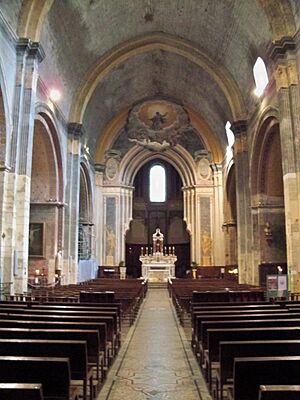Ancient Diocese of Orange facts for kids
The ancient Diocese of Orange was a special church area in a place called the Comtat Venaissin in Provence, France. This area used to belong to the Pope! During the French Revolution, the French government closed down this diocese. Later, in 2009, it was brought back as a "titular see" for the Catholic Church. This means it's a title given to bishops who don't have a specific church area to lead, but still hold the rank of a bishop.
Contents
History of the Diocese
The city we now call Orange in southern France was known as Arausio in Roman times. It was first set up as a place for Roman Army veterans to retire after fighting for Emperor Augustus.
Early Church in Orange
Orange likely became home to a bishop around the late 200s AD. We know this because a priest from Orange, named Faustinus, represented its bishop at an important meeting called the Synod of Arles in 314 AD. The first bishop whose name we know for sure was Constantius, who attended another meeting, the Council of Aquileia, 381, in 381 AD. From the early 400s, the bishop of Orange was under the authority of the main church leader in Arles.
Important Church Meetings
Orange was the location for two very important church meetings, called synods, in 441 and 529 AD. The Second Council of Orange in 529 was especially significant. At this meeting, church leaders spoke out against an idea called Semipelagianism, which was a belief about how people become good Christians.
Changes Over Time
In 1516, the King of France, Francis I of France, decided that the area around Orange should be joined with another French region called the Dauphiné. This meant that the Bishop of Orange, in terms of his worldly rights and duties, now had to answer to the King of France.
The Diocese Closes and Reopens
During the French Revolution, many old church structures in France were changed or closed. The Diocese of Orange was one of them. In 1801, Pope Pius VII officially joined the territory of Orange to the Archdiocese of Avignon.
Later, after the French Emperor Napoleon Bonaparte was defeated, there were plans to bring the bishopric of Orange back as a full residential diocese. However, the French government didn't agree to the new plan, so it didn't happen.
Because of this, the ancient church area of Orange is no longer a place where a bishop lives and leads a specific group of churches. But in January 2009, Pope Benedict XVI decided to bring back the "title" of Bishop of Orange. This title is now given to bishops who work in other roles, like helping out in other dioceses or working for the Pope in Rome. It's a way to honor the long history of the diocese.
Currently, since 2012, Archbishop Julio Murat holds this title. He works as an Apostolic Nuncio (which is like an ambassador for the Pope) in Cameroon and Equatorial Guinea.
Bishops of Orange
Many bishops led the Diocese of Orange throughout its long history. Some early lists of bishops before 347 AD were made up by a historian named Polycarpe de la Rivière and are not supported by clear evidence.
Here are some of the earliest known bishops:
- Faustinus (a priest representing the bishop) in 314
- Constantius in 381
- Marin in 433
- Justus around 440-455
- Eutropius of Orange around 455-475
- Verus
- Florentius of Orange from 517-524
- Vindemialis from 527-549
Many other bishops served the diocese over the centuries until its closure in 1790. The last bishop was Guillaume-Louis du Tillet, who served from 1774 until the diocese was suppressed during the French Revolution.
See also
- Catholic Church in France
- List of Catholic dioceses in France
Images for kids



